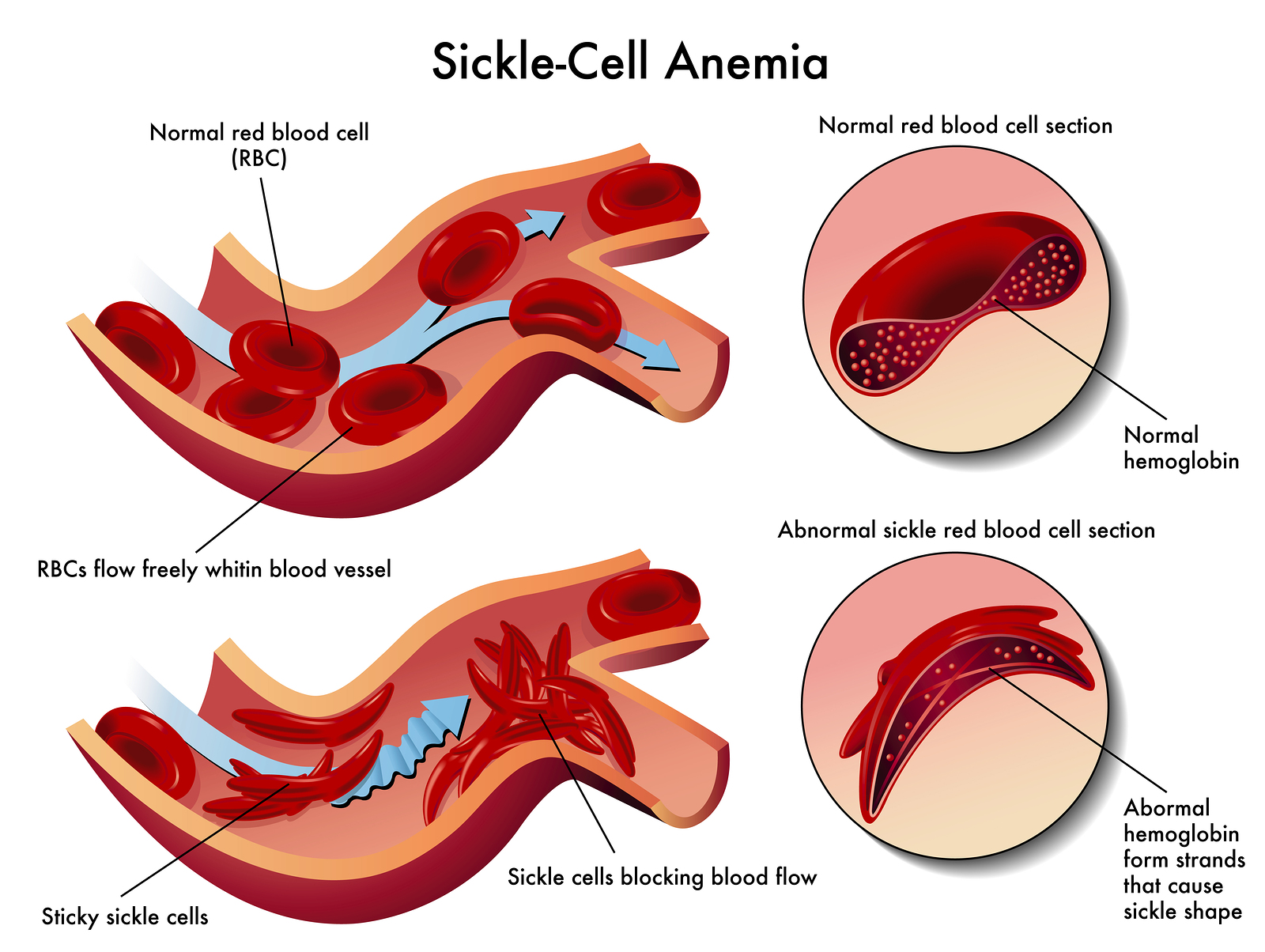You may have heard about sickle cell anaemia, but do you know how it is different from general anaemia? If you want to know more about its symptoms or treatment, read on. In this article, we will discuss everything about the causes of Sickle Cell Anaemia.
Sickle cell anaemia happens to be a disorder of the blood. It is a genetic disorder that is characterised by sickle-shaped red blood cells. In most cases, it has been observed that Africans and African Americans are the most affected by this type of disease.
Geographically, this blood disorder is most prevalent in Africa. In the United States, close to 100,000 Americans are victims of sickle cell anaemia. It happens to be one of the most common genetically inherited disorder of the blood in the United States, and close to one in every five hundred African Americans are diagnosed with sickle cell anaemia. (1)
In this article, you will learn about what sickle cell anaemia is, the causal factors, the symptoms associated with it, and the treatment and diagnosis.
Contents
What is sickle cell anaemia disease?
Sickle cell anaemia is a medical condition that involved the red blood cells of the body. It’s is a genetic disease. Typically, red blood cells have a disc-like shape. This is to ensure flexibility and agility for the cells to travel through the body, primarily through extremely small blood vessels. (2)
However, in the case of those suffering from sickle cell anaemia, the red blood cells are shaped like a sickle or a crescent. Additionally, their red blood cells are rigid and sticky. This makes it difficult for the red blood cells to pass easily across the body and blood vessels.
Instead, the red blood cells get trapped when it passed through thin or small blood vessels, thereby blocking the blood from passing through and accessing various parts of your body. When this happens, the individual experiences tissue damage and chronic pain. (36)
Unfortunately, no effective cure has been found to date. However, there are treatments and medical care which are available that can help relieve any pain associated with it, as well as the risk factors and complications that this disease can give rise to. (3)

What are the causes of sickle cell anaemia?
As we mentioned above, sickle cell anaemia is a genetic disease. It happens when there is a mutation in the gene that is responsible for making haemoglobin or the red compounds in the blood that is rich in iron. (4)
The function of haemoglobin is to enable the red blood cells to carry oxygen to every part of your body, from the lungs. In an individual who is suffering from sickle cell anaemia, the haemoglobin has an abnormality which causes it to dysfunction. Because of the mutation of the gene that is responsible for haemoglobin, the red blood cells become sticky, rigid, and unable to perform the necessary function. (5)
Faulty genes are responsible for this condition. This is known as autosomal recessive inheritance. The sickle cell gene is passed on from one generation to the next, in a specific pattern of inheritance. Additionally, for the child to be affected, both parents, the mother and the father, will have to pass on the sickle cell gene to the child.
In case only one parent has the sickle cell gene and passes this on to the child, then the child will have something known as the sickle cell trait. In such cases, the child will have one healthy, typical form of the haemoglobin gene, as well as a defective, sickle cell form of the haemoglobin gene.
Such individuals will have blood that contains a few sickle cells. In most cases, such people do not have the signs and symptoms of sickle cell anaemia. However, it is worth noting that such individuals are carriers of the sickle cell gene, which makes them candidates who are capable of passing on the gene to the next generation through their children. (6)
What are the signs and symptoms of sickle cell anaemia?
There are a few signs and symptoms that are associated with people with sickle cell anaemia. These symptoms can vary from one individual to another. The symptoms are listed below –
Anaemia
One of the most common and first symptoms that an individual who is suffering from sickle cell anaemia will experience is anaemia. This is because the sickle cells in the body are deformed and are prone to easy breakage, and they die.
Essentially, the life span of red blood cells is around 120 days. In the case of sickle cell anaemia, the lifespan of the cells is extremely short as they die soon, within a span of approximately ten to twenty days. When this happens, you experience a shortage in the number of red blood cells, which in turn leads to anaemia. (7)
Problems with vision
As we’ve mentioned before, the flexibility and movement of sickle cells are compromised and restricted. Because of their crescent shape as well as their rigidity and stickiness, it becomes hard for the sickle cells to pass through thin blood vessels.
The eyes contain thin blood vessels, and the sickle cells find it hard to pass through these vessels, thereby inhibiting the supply of blood to your eyes. So, a common symptom of sickle cell anaemia is problems associated with vision. (8)
Delay in growth
In case you didn’t know, your body requires excellent blood flow and oxygen for it to function. This also helps with the development of the body. Red blood cells transport oxygen and blood to the entire body, but this process is hindered if you are suffering from sickle cell anaemia.
It has been observed that children and infants who suffer from sickle cell anaemia show signs of slow growth. Additionally, delayed puberty is seen in teenagers. (9)
Infections
You are likely to be more prone to infections if you are suffering from sickle cell anaemia. Your spleen is responsible for warding off infections and keeping diseases at bay. The spleen is extremely crucial as it filters the blood and recycles the old red blood cells. However, sickle cells are known to damage the spleen.
When the spleen is damaged, your chances of fighting an infection is compromised. This makes you vulnerable to any infections that come your way, particularly meningitis and pneumonia. It is common practice for doctors to subscribe sickle cell anaemia vaccinations as well as antibiotics for children, to help them steer clear of infections. (10)
Swelling
It is common to experience swelling, particularly of your hands and feet, if you are suffering from sickle cell anaemia. This is because your hands and feet do not get enough blood flow. The cells find it hard to travel to your hands and feet, thereby causing a lack of adequate blood supply. (11)
Crises
Crises or periodic episodes of pain is one of the major symptoms of sickle cell anaemia. What triggers this pain is the blockage of blood flow. The red blood cells that are sickle in shape does not pass easily through the blood vessels and can cause a blockage of blood flow to various parts of your body like your joints, chest, and abdomen.
In some cases, periodic episodes of pain have been observed in the bones as well.
The intensity, as well as the duration of the pain, is different from person to person. In some, it can last for a few hours, while for others, it can last for up to a few weeks. In a few individuals who suffer from sickle cell anaemia, the episodes of pain occur only a few times in their lifetime.
However, there are a few cases wherein it appears as frequent as a dozen or more times in a single year. If the crises or pain episodes are incredibly severe, hospitalisation may be required. (12)
What are the complications of sickle cell anaemia?
Sickle cell anaemia can pave the way to a host of complications. Unfortunately, this condition includes your red blood cells, which plays a crucial role in both the development and function of your body. Let’s look at the complications of sickle cell anaemia.
Loss of vision
As mentioned above, one of the symptoms of sickle cell anaemia is disturbed vision. Over time, if you are suffering from sickle cell anaemia, you are at the risk of blindness. Red blood cells that are sickle in shape find it hard to pass through tiny blood vessels.
Your eyes contain extremely tiny blood vessels. The rigidity and the stickiness of infected cells can block the flow of blood to your eyes, thereby rendering you blind. (13)
Strokes
A stroke is a medical condition that requires immediate attention. It happens when blood flow and oxygen is restricted to your brain. The most common signs of a stroke are weakness, numbness in your legs and arms, an unexplained and sudden difficulty with speech, seizures, and the loss of consciousness.
In those suffering from sickle cell anaemia, the flow of blood, as well as oxygen, is restricted. This restriction can include the loss and inhibition of blood and oxygen to the brain as well, which causes a stroke. Make sure you bring this to the notice of your health care provider if you observe any signs of a stroke. (14)
Pulmonary hypertension
Sickle cell anaemia can cause pulmonary hypertension. This is a medical condition that is characterised by high blood pressure in the lungs. In most cases, pulmonary hypertension is observed in adults as opposed to children. However, the occurrence of pulmonary hypertension in children cannot be ruled out as well. Some signs and symptoms associated with pulmonary hypertension are extreme, unexplained fatigue and difficulty breathing. (15)
Gallstones
You will experience the presence of gallstones in your body if there is an excessive amount of bilirubin in your body. This substance is produced when red blood cells in your body are broken down. In the case of sickle cell anaemia, red blood cells are continually being broken down. This cause an increase in the production of bilirubin, which in turn can lead to the formation of gallstones in your body. (16)
Leg Ulcers
When there is an inadequate flow of blood and circulation in your legs, you will begin to develop open sores or ulcers. Sickle cell anaemia, as we know, can inhibit the flow of blood to your legs and hands. In such cases, it can pave the way to ulcers. (17)
Damage of organs
Each of your organs requires enough oxygen and blood flow to function well. If your organs are deprived of blood flow and oxygen, the nerves and tissues tend to get damaged, resulting in organ damage. Sickle cell anaemia, as we mentioned before, can result in the restriction of blood flow and oxygen to the various parts of your body, including your organs. The damage to your organs can prove to be fatal. (18)
Acute chest syndrome
This is a medical condition that is characterised by fever, chest pain, and difficulty breathing. In most cases, it is caused by a lung infection. However, sickle cells can cause this condition as well. It happens when the sickle-shaped red blood cells block the blood vessels that are present in your lungs. It can be a life-threatening condition. (19)
Priapism
Priapism is a medical condition that causes men to have a painful erection for long periods. In this case, as well, the blood vessels in the penis are blocked by the sickle cells.
(20)
Sickle Cell Anaemia Diagnosis
A simple blood test can help with the diagnosis of sickle cell anaemia. In a blood test, the doctor will check for the presence of haemoglobin S- also called the abnormal haemoglobin. In certain countries like the United States, all newborn babies checked for sickle cell anaemia.
To check for sickle cell anaemia in adults, doctors test a blood sample from the vein of your arm. To check for sickle cell anaemia in children and infants, they draw a blood sample from the heel or finger. They will screen you for haemoglobin S based on this sample. (21)
In case your results are positive, you will be subjected to additional tests. These tests are usually done to check if you have one or two sickle cell genes in your body.
To check for sickle cell anaemia in unborn babies, a sample is taken from the amniotic fluid. This is the fluid that is present in the mother’s womb. The fluid is checked for sickle cell genes. (22)
Sickle Cell Anaemia Treatment in India?
Let’s look at the treatment methods associated with sickle cell anaemia…
Bone Marrow Transplant
One of the only potential treatments for sickle cell anaemia is a bone marrow transplant. This is a stem cell transplant. However, this treatment is usually for patients below the age of sixteen years old. This is because older people can face more risks as opposed to those who are younger. (23)
A part of the treatment for sickle cell anaemia deals with crises. Doctors may treat patients with sickle cell anaemia for the pain associated with emergencies. In most cases, the doctor will advise you to pay a visit to the doctor at least once a year, especially in the case of adults and children who are older than two years of age. (24)
Medications for sickle cell anaemia
As mentioned above, one of the only potential cures for sickle cell anaemia is a bone marrow transplant. There are a few medications available for sickle cell anaemia, but doctors prescribe these medications for fighting infections, treat infections, and address and manage the pain caused by sickle cell anaemia. These medications are as follows:
Antibiotics for sickle cell anaemia
In most cases, if an infant tests positive for sickle cell anaemia, doctors will administer a medicine known as penicillin. Usually, infants get this drug once they are two months old. The medication will continue until the age of five. The use of this drug is to keep infections like meningitis and pneumonia at bay.
In the case of an adult, penicillin will be given if you have had a history of pneumonia or if your spleen has been removed. (25)
Pain killer
In some cases, pain-relieving medication will be administered to those who are suffering from sickle cell anaemia. As we’ve mentioned above, individuals who suffer from sickle cell anaemia experience sudden episodes of pain known as crises. Doctors may prescribe pain-relieving medications to manage these episodes of pain.
(26)
Hydroxyurea
Hydroxyurea can reduce the occurrence of crises or episodes of pain. Additionally, it can lower the requirement for blood transfusions as well. It does this by increasing the production of fetal haemoglobin. Fetal haemoglobin is a type of haemoglobin that can help prevent the formation of sickle cells as well as destroy sickle cells.
However, one drawback of hydroxyurea is that it can increase your chances of getting an infection. More studies and research will be required to determine the effectiveness of hydroxyurea on individuals who are suffering from sickle cell anaemia. Doctors advise pregnant women not to take this drug.
(27)
Experimental treatments
As mentioned above, one of the only potential cure for sickle cell anaemia is a bone marrow transplant. However, researchers are working on some innovative treatments that could prove to be effective in treating sickle cell anaemia. These are as follows –
Gene Therapy
This particular treatment includes the insertion of a normal, healthy gene into the bone marrow of the individual suffering from sickle cell anaemia. In this way, there could be a possibility of restoring normality to the haemoglobin in your body. Additionally, scientists are conduction research to see if the defective haemoglobin gene can be turned off.
(28)
Nitric Oxide Treatment
Those who suffer from sickle cell anaemia have a lower than normal levels of nitric oxide present in their blood. One of the functions of nitric oxide is that it can help keep the blood vessels open. Additionally, it can lower the level of stickiness sickle cells. However, there is not enough research to actively support the possibility of this treatment. (29)
Drugs for fetal haemoglobin production
There is something known as fetal haemoglobin. The primary function of this is to destroy haemoglobin S or sickle cells or to inhibit the formation of sickle cells. Doctors may administer drugs to increase the production of fetal haemoglobin. However, these experiments are ongoing, and there are insufficient information and research based on this. (30)
How to manage sickle cell anaemia
There are a few lifestyle changes that you can adapt as well as home remedies, which can help you manage sickle cell anaemia and avoid the complications associated with it. These are the following:
Water
The chances of your having a sickle cell crisis or episodes of pain are increased when you are dehydrated. This is why it is imperative to stay hydrated at all times, particularly if you are suffering from sickle cell anaemia. You must drink close to eight glasses of water every day and avoid dehydration.
In case you indulge in physical exercises and activity, you will have to increase your intake of water. Additionally, if you happen to reside in an area that is hot and dry, make sure you increase your daily intake of water. (31)
Stay away from areas that have extreme temperatures
Regions that are too hot or too cold might increase your chances of getting frequent episodes of pain or sickle cell crisis. If you are residing in such an area, you will have to consider relocating to a region that is less extreme. (32)
Exercise
Make sure you incorporate a light exercise regime as a part of your daily activity. However, you need to avoid extremely vigorous exercise. You can consult your health care provider to ask for details as to the kind of tasks that are advisable for you.
(33)
Folic acid supplements
Your bone marrow requires a good amount of folic acid. Taking folic acid supplements, as well as incorporating colourful fruits and vegetables and whole grains, can be beneficial for your bone marrow. With the help of folic acid, bone marrow can help produce new cells. Make sure you talk to your doctor before you go ahead and take the folic acid supplements. (34)
In conclusion
Scientists have conducted studies on the rate of mortality concerning sickle cell anaemia. They conclude concluded that close to 50% of the individual who suffers from sickle cell anaemia survive for over fifty years of their lifespan. Most deaths associated with sickle cell anaemia were the result of sickle cell crises, strokes, or acute chest syndrome. The earlier you detect the symptoms, the better your chances of excellent treatment. (35)
Sickle cell anaemia can be a painful health disorder. If you or a loved one is suffering from sickle cell anaemia, make sure you pay a visit to your health care provider at least once every six months or twice a year.
FAQ
Q1: What is meant by sickle cell anaemia?
Sickle cell anaemia is a genetic disorder of the blood. In sickle cell anaemia, the red blood cells become sickle-shaped. It is more prevalent among Africans and African Americans. In USA, it is counted as one of the most common genetically inherited blood diseases, and roughly one in every 500 five hundred African Americans are diagnosed with sickle cell anaemia. (1)
Q2: Is sickle cell anaemia inherited?
Yes. Sickle cell anaemia is a genetic disorder, which means it is inherited.
Q3: How to manage sickle cell anaemia?
Sickle cell anaemia cannot be cured, but can be managed. While there are no medicines as such to manage the condition, doctors can administer medicines or treatment as needed when the crises manifests. This can include antibiotics, painkillers, vitamins and even blood transfusions. (32)
Q4: What mutation causes sickle cell anaemia?
Sickle cell anaemia is caused by mutations in the HBB gene. The HBB gene is responsible for making haemoglobin- the protein that carries oxygen to the blood cells. A person gets sickle cell anaemia when she inherits an abnormal copy the gene from both parents. People who inherit only one abnormal copy of the gene are usually not affected by it, and instead act as carriers of the disease. (36)
Q5: Why is aspirin used to treat sickle cell anaemia?
While sickle cell anaemia has no treatment, the crises symptoms can be treated. Aspirin is effective if fever sets in. Also, a study found that administering aspirin to patients resulted in fewer crises episodes. However, any medication should be taken only after consulting with the doctor. (37)
Q6: What is the difference between thalassemia and sickle cell anaemia?
While both sickle cell anaemia and thalassemia are inherited blood disorders, they are different. In thalassemia, the red blood cells do not get distorted into a sickle-shape. Thalassemia can lead to iron overload, which is not the case with sickle cell anaemia. The latter is most prevalent among Africans and African Americans. Thalassemia, on the other hand, is more common among people of Greek, Italian, Middle Eastern, South Asian and African origin. It is more commonly occurring than sickle cell anaemia.
Q7: How is sickle cell anaemia inherited?
Children can inherit sickle cell anaemia from their parents. If both the parents are carriers of the mutated HBB gene, they will pass it on to their kids. A person who receives the abnormal gene from both the parents will get sickle cell anaemia. However, if he gets the mutated gene from only one parent, he is characterised by the “single cell trait”. While he himself may not exhibit any symptoms of the disease, he may pass it on to his children. (36)
Q8: How to cure sickle cell anaemia?
Unfortunately, no such cure is available for sickle cell anaemia. One of the only potential treatments for sickle cell anaemia is a bone marrow transplant. This is a stem cell transplant. However, this treatment is usually for patients below the age of sixteen years old. This is because older people can face more risks as opposed to those who are younger. (23)
Q9: How to prevent sickle cell anaemia?
Since it is a genetic disorder, you cannot prevent sickle cell anaemia. However, you can manage it. You must stay hydrated, avoid extreme temperatures, lead a stress-free life and follow a healthy diet. While strenuous activities have to be avoided, you can stay active by doing light exercises. Doctors also prescribe folic acid supplements for patients, which is good for the bone marrow.
Q10: Is sickle cell anaemia dominant or recessive?
Sickle cell anaemia is carried in a recessive allele of the haemoglobin. This means that unless you inherit it from both your parents, you won’t be affected by the disease yourself. If you inherit it from one parent, and a normal gene from the mother, you will become a carrier of the disease.
Q11: What are the symptoms of sickle cell anaemia?
Symptoms of sickle cell anaemia are: blurred vision, an increased tendency towards infections, delayed growth, swelling in hands and feet, fatigue and anaemia.
Q12: What causes sickle cell anaemia?
Sickle cell anaemia can manifest in crisis- periodic episodes of pain. This is because the sickle-shaped blood cells find it difficult to pass through blood vessels, and this hampers normal functioning of internal organs. Conditions like extreme temperatures, stress, dehydration and high altitudes can trigger crises.







